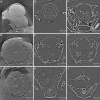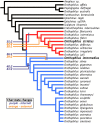Preservation of three-dimensional anatomy in phosphatized fossil arthropods enriches evolutionary inference
- PMID: 26854367
- PMCID: PMC4758943
- DOI: 10.7554/eLife.12129
Preservation of three-dimensional anatomy in phosphatized fossil arthropods enriches evolutionary inference
Abstract
External and internal morphological characters of extant and fossil organisms are crucial to establishing their systematic position, ecological role and evolutionary trends. The lack of internal characters and soft-tissue preservation in many arthropod fossils, however, impedes comprehensive phylogenetic analyses and species descriptions according to taxonomic standards for Recent organisms. We found well-preserved three-dimensional anatomy in mineralized arthropods from Paleogene fissure fillings and demonstrate the value of these fossils by utilizing digitally reconstructed anatomical structure of a hister beetle. The new anatomical data facilitate a refinement of the species diagnosis and allowed us to reject a previous hypothesis of close phylogenetic relationship to an extant congeneric species. Our findings suggest that mineralized fossils, even those of macroscopically poor preservation, constitute a rich but yet largely unexploited source of anatomical data for fossil arthropods.
Keywords: Histeridae; Paleogene; X-ray imaging; evolutionary biology; fissure fillings; genomics; internal characters; onthophilus spp. (coleopera: histeridae).
Conflict of interest statement
The authors declare that no competing interests exist.
Figures







References
-
- Allison PA, Bottjer DJ. Taphonomy: bias and process through time. In: Allison PA, Bottjer DJ, editors. Taphonomy. Dordrecht: Springer Netherlands; 2011. pp. 1–17. - DOI
-
- Anderson LI, Trewin NH. An Early Devonian arthropod fauna from the Windyfield cherts, Aberdeenshire, Scotland. Palaeontology. 2003;46:467–509. doi: 10.1111/1475-4983.00308. - DOI
-
- Bajerlein D, Matuszewski S, Konwerski S. Insect succession on carrion: seasonality, habitat preference and residency of histerid beetles (Coleoptera: Histeridae) visiting pig carrion exposed in various forests (Western Poland) Polish Journal of Ecology. 2011;59:787–797.
-
- Barling N, Martill DM, Heads SW, Gallien F. High fidelity preservation of fossil insects from the Crato Formation (Lower Cretaceous) of Brazil. Cretaceous Research. 2015;52:605–622. doi: 10.1016/j.cretres.2014.05.007. - DOI
-
- Betz O, Wegst U, Weide D, Heethoff M, Helfen L, Lee W-K, Cloetens P. Imaging applications of synchrotron X-ray phase-contrast microtomography in biological morphology and biomaterials science. I. General aspects of the technique and its advantages in the analysis of millimetre-sized arthropod structure. Journal of Microscopy. 2007;227:51–71. doi: 10.1111/j.1365-2818.2007.01785.x. - DOI - PubMed
MeSH terms
LinkOut - more resources
Full Text Sources
Other Literature Sources
Miscellaneous

